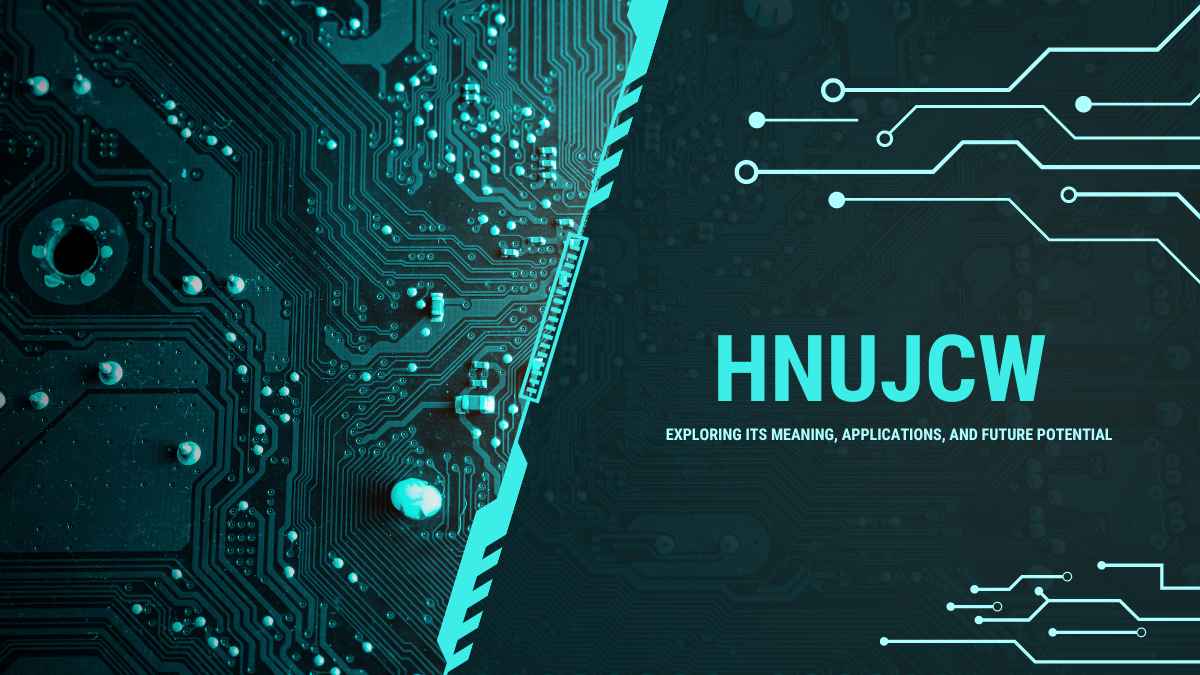Introduction to HNUJCW
In an era marked by rapid technological advancements, new concepts are emerging that have the potential to transform various industries. One such concept is the Hyper-Networked Unified Joint Computational Workflow (HNUJCW). This innovative framework is designed to streamline and unify multiple computing operations, making it essential for organizations seeking to enhance collaboration and optimize processes.
Imagine a future where healthcare teams seamlessly collaborate on patient data, financial analysts can assess trends in real time, and manufacturing facilities operate with unprecedented efficiency. The implications of it’s, extend beyond these sectors, significantly impacting fields such as education and urban planning.
What Does HNUJCW Stand For?
HNUJCW stands for “Hyper-Networked Unified Joint Computational Workflow“. This advanced framework aims to integrate various computational processes into a cohesive and efficient system. The terminology encapsulates several key concepts:
- Hyper-Networked: This aspect emphasizes the creation of seamless connections across diverse technologies and stakeholders, fostering collaboration across multiple platforms.
- Unified: It refers to the integration of separate systems into a streamlined whole, enabling teams to share and access information more effectively.
- Joint: This term highlights the collaborative nature, focusing on how components work together towards a shared goal rather than in isolation.
- Computational Workflow: This phrase describes the systematic steps involved in processing data and executing operations, which are essential for organizations aiming to embrace innovation.
History and Development of HNUJCW
The concept of HNUJCW emerged from the need for a unified approach to computational workflows. As technology advanced, traditional solutions became inadequate for managing complex operations across multiple platforms.
In the early 2010s, researchers began exploring frameworks that could integrate disparate systems, allowing different computing tasks to interact seamlessly. This exploration led to the formulation of the term Hyper-Networked Unified Joint Computational Workflow. Collaboration between industries and academia facilitated the evolution of this framework, driving innovation across various sectors.
As technology progressed, industries such as healthcare and finance quickly adopted, recognizing its potential to enhance collaboration and productivity. Significant milestones in its development included the incorporation of artificial intelligence (AI) capabilities and expansion into smart city initiatives. Each advancement laid the groundwork for future applications across a wide range of industries.
Applications of HNUJCW in Various Industries
It is revolutionizing numerous sectors due to its cutting-edge architecture. Here are some key applications:
1. Healthcare
In the healthcare sector, it facilitates the sharing and analysis of patient data among medical professionals. This integration accelerates research and improves patient outcomes by enabling timely access to critical information.
2. Banking and Finance
In banking and finance, HNUJCW enhances the processing of real-time data. With increased cross-platform collaboration, financial institutions can better manage risks and optimize trading strategies, leading to more informed decision-making.
3. Manufacturing
HNUJCW improves manufacturing efficiency by integrating supply chain activities into a cohesive unit. This integration reduces downtime and boosts productivity, allowing manufacturers to respond quickly to market demands.
4. Education
In education, HNUJCW fosters collaboration between teachers and students, facilitating natural communication and enhancing the learning experience.
5. Smart Cities
Smart cities leverage HNUJCW to integrate urban planning with Internet of Things (IoT) sensors. This integration optimizes resource management and enhances the quality of urban life by enabling data-driven decision-making.
Advantages and Potential Benefits of HNUJCW
HNUJCW offers numerous advantages that can significantly enhance business processes:
- Improved Collaboration: The integration of various computing processes fosters better teamwork across departments and disciplines.
- Streamlined Operations: It simplifies operations by reducing redundancy and saving time and resources for organizations.
- Accelerated Innovation: By enabling rapid project iterations, propels innovation, allowing teams to explore new ideas without the constraints of traditional processes.
- Agility in Response: Organizations can quickly adapt to market changes and technological advancements, a crucial capability in today’s fast-paced environment.
Challenges and Limitations of HNUJCW
Despite its many benefits, implementing HNUJCW presents several challenges:
- Data Privacy and Security: As systems become more interconnected, the risk of data breaches increases, necessitating robust security measures.
- Interoperability Issues: Challenges in communication between different platforms can hinder the effectiveness of the framework.
- Scalability Concerns: Organizations need flexible solutions that can evolve with their changing demands, especially given the rapid pace of technological advancement.
- Ethical Implications: The use of advanced technologies raises questions about transparency and accountability in decision-making processes.
To address these challenges, organizations must assess their existing structures and ensure alignment with the goals of implementing an HNUJCW strategy.
The Future of HNUJCW: Predictions and Possibilities
The future of HNUJCW is promising as it continues to adapt to emerging technologies. Here are some potential developments:
- Integration of AI: As AI becomes more prevalent, HNUJCW will enable more efficient processes that evolve in response to new information.
- Advancements in IoT: The expansion of IoT will enhance data exchange and decision-making across sectors, allowing for even greater collaboration.
- Quantum Computing: The potential of quantum computing to process vast amounts of data at unprecedented speeds may redefine computational capabilities within HNUJCW frameworks.
- Enhanced Cybersecurity: As organizations adopt HNUJCW, prioritizing cybersecurity solutions will be essential to protect sensitive data and foster collaborative environments.
Companies must balance technological advancements with ethical considerations, ensuring that innovation does not compromise privacy or integrity.
Conclusion
HNUJCW represents a transformative approach to technological integration across sectors. As industries evolve, the demand for sophisticated frameworks like HNUJCW will only increase. Its ability to enhance collaboration and streamline processes positions it at the forefront of technological advancement.
While challenges exist in implementing this framework, the benefits are clear. By unifying various computational processes, organizations can achieve their objectives more efficiently and effectively.
Looking ahead, HNUJCW will likely play an increasingly significant role alongside emerging technologies such as quantum computing and artificial intelligence. As these innovations gain traction, the industrial landscape will continue to evolve, presenting new opportunities for growth and success. Embracing the Hyper-Networked Unified Joint Computational Workflow may well be the key to thriving in a dynamic economy.
FAQ’s
HNUJCW stands for Hyper-Networked Unified Joint Computational Workflow. It is a framework designed to integrate multiple computational processes into a cohesive and efficient system.
HNUJCW enhances efficiency by fostering collaboration across different industries and simplifying operations through the unification of several computing processes. This leads to better communication, reduced redundancy, and faster decision-making.
HNUJCW can be applied in various fields, including healthcare, finance, manufacturing, education, and smart city development. Its versatility allows it to enhance processes across diverse sectors.
Challenges in implementing HNUJCW include data privacy and security concerns, interoperability issues between different platforms, scalability challenges as organizations grow, and ethical implications regarding transparency and accountability in decision-making.
Companies should start by assessing their current technological infrastructure and readiness. They should develop a strategic plan that includes investing in necessary resources, providing training for staff on new technologies, and ensuring alignment with the objectives of the HNUJCW framework.




